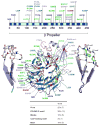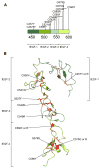Glanzmann thrombasthenia: state of the art and future directions
- PMID: 23929305
- PMCID: PMC4011384
- DOI: 10.1055/s-0033-1353393
Glanzmann thrombasthenia: state of the art and future directions
Abstract
Glanzmann thrombasthenia (GT) is the principal inherited disease of platelets and the most commonly encountered disorder of an integrin. GT is characterized by spontaneous mucocutaneous bleeding and an exaggerated response to trauma caused by platelets that fail to aggregate when stimulated by physiologic agonists. GT is caused by quantitative or qualitative deficiencies of αIIbβ3, an integrin coded by the ITGA2B and ITGB3 genes and which by binding fibrinogen and other adhesive proteins joins platelets together in the aggregate. Widespread genotyping has revealed that mutations spread across both genes, yet the reason for the extensive variation in both the severity and intensity of bleeding between affected individuals remains poorly understood. Furthermore, although genetic defects of ITGB3 affect other tissues with β3 present as αvβ3 (the vitronectin receptor), the bleeding phenotype continues to dominate. Here, we look in detail at mutations that affect (i) the β-propeller region of the αIIb head domain and (ii) the membrane proximal disulfide-rich epidermal growth factor (EGF) domains of β3 and which often result in spontaneous integrin activation. We also examine deep vein thrombosis as an unexpected complication of GT and look at curative procedures for the diseases, including allogeneic stem cell transfer and the potential for gene therapy.
Thieme Medical Publishers 333 Seventh Avenue, New York, NY 10001, USA.
Figures


References
-
- George JN, Caen JP, Nurden AT. Glanzmann’s thrombasthenia: The spectrum of clinical disease. Blood. 1990;75:1383–1395. - PubMed
-
- Nurden AT, Fiore M, Nurden P, Pillois X. Glanzmann thrombasthenia: a review of ITGA2B and ITGB3 defects with emphasis on variants, phenotypic variability, and mouse models. Blood. 2011;118:5996–6005. - PubMed
-
- Nurden AT, Pillois X, Nurden P. Understanding the genetic basis of Glanzmann thrombasthenia: Implications for treatment. Exp Rev Hematol. 2012;5:487–503. - PubMed
-
- Arnaout MA, Mahalingam B, Xiong JP. Integrin structure, allostery, and bidirectional signalling. Annu Rev Cell Biol. 2005;21:381–410. - PubMed
Publication types
MeSH terms
Substances
Grants and funding
LinkOut - more resources
Full Text Sources
Other Literature Sources
Medical
Molecular Biology Databases
Miscellaneous

